Liberalization, Trans-European Corridors and EU Funds: A New Scenario in the Relationship between Rail Networks and Mediterranean Cities
Abstract
1. Introduction
Theoretical Framework: City and High-Speed Rail in Spain
2. Materials and Methods
- Official Work Plans of the European Coordinator for the Mediterranean Corridor of the European Commission for 2020–2021 and 2022–2023.
- Official documents from the Spanish infrastructure manager, ADIF, on high-speed rail transport and investments in the 20 years of existence of this type of transport (1992–2022).
- Personal notes from the authors’ participation in the ordinary meetings of the European Forum of the Mediterranean Corridor (European Commission) between 2018 and 2023.
- Presentations by different Spanish cities and the rest of the European Union in the Thematic Working Group meetings dedicated to urban nodes within the activities of the European Mediterranean Corridor of the TEN-T network.
- Fieldwork on work sites in three cities along the Mediterranean Corridor in Spain: Barcelona, Valencia, and Murcia.
- The general considerations of the working documents of the European Coordinator for the Mediterranean Corridor (part of the TEN-T network) regarding the issue of urban nodes and their morphological and functional needs concerning the said network. These documents are compulsorily written by the different coordinators of the TEN-T network, and they have allowed us to explore this relationship between rail and urban nodes.
- The case studies of European cities as the general context for a practical response to the previous considerations.
- The case studies of Spanish cities according to specific actions resulting from their inclusion in the TEN-T network and, specifically, the Mediterranean Corridor.
3. Results
3.1. Theoretical Research: The Significance of Urban Nodes in the TEN-T Network Literature
“Urban node’ means an urban area where the transport infrastructure of the trans-European transport network, such as ports including passenger terminals, airports, railway stations, logistic platforms and freight terminals located in and around an urban area, is connected with other parts of that infrastructure and with the infrastructure for regional and local traffic”[43]
- The combination of geographical and economic criteria;
- The identification of urban nodes as a framework for the network;
- Multimodal connections between nodes, based on traffic flow.
- Capital city of each member state;
- All metropolitan growth areas (following ESPON criteria);
- Conurbations of urban clusters (including their corresponding peripheries), as defined by the corresponding LUZ (larger urban zones, according to EUROSTAT and Urban Audit)
- The main border-crossing point for each mode of transport (between member states and between member states and non-EU neighbors).
“Urban nodes play an important role within the multimodal Core Network, with regard to their infrastructure both for passengers and for freight. Apart from their wide range of economic, social and cultural functions, for the Union’s transport system, they are particularly relevant in the following respect: (1) they connect network links—both of the core and the comprehensive networks; (2) they interconnect transport modes, thus enhancing multimodality; (3) they connect long distance and/or international with regional and local transport (passengers and freight)”[46]
“Urban nodes represent most of the points of origin and destination of transport flows on the Corridors. The effectiveness of the Corridors is therefore impacted by the effectiveness of the first and last miles of the journeys in those urban nodes and it is important to ensure sufficient multimodal connections. Urban nodes can also contain bottlenecks and missing links on the Corridors; conversely, they can be impacted by the negative aspects of traffic on the Corridors in terms of pollution, noise, and safety”.
3.2. Liberalization: More Trains in Cities
- Package A: Renfe Viajeros, a selected company with 96 AVE trains, which will occupy an average of 86% of the capacity offered for this package in all three corridors. In this way, it increases its current offer by 20%. The launch of the operation is to take place between the end of 2020 and the end of 2030.
- Package B: ILSA, with 23 Frecciarossa 1000 trains, which will occupy an average of 70% of the capacity offered for this package in all three corridors. The services of its trademark company, IRYO, began in November 2022 between Madrid and Barcelona, in December between Madrid and Valencia, and in April 2023 between Madrid and Seville.
- Package C: RIELSFERA, which will operate with 10 Alstom Duplex trains (bilevel) and occupy 100% of the capacity offered for this package in all three corridors. Its services began in May 2021 between Madrid and Barcelona and in October 2022 between Madrid and Valencia.
3.3. New Sources of Funding: Next Generation Funds
4. Case Studies
4.1. European Cities along the Mediterranean Corridor: Concerns and Actions
- The morphological and functional consequences of their status as an urban node in the TEN-T network.
- Urban nodes need to be analyzed, not only in the context of the core network corridor (CNC) but also in a regional framework.
- Due to the relevant costs, it is necessary to finance many of these projects from different sources, especially EU Funds.
- CNC Fora could be useful for learning lessons from other success stories.
4.2. The Case Study of the Spanish Mediterranean Corridor: Barcelona, Valencia, and Murcia
4.2.1. Barcelona
4.2.2. Valencia
4.2.3. Murcia
5. Discussion and Conclusions
Author Contributions
Funding
Data Availability Statement
Acknowledgments
Conflicts of Interest
| 1 | The Large Urban Areas (GAUs) are 86 areas with more than 50,000 inhabitants (single or multi-state), grouping a total of 755 municipalities in which 32 million people live (2019). This means that 69.29% of the total population lives in 9.3% of Spanish municipalities |
| 2 | The SUMP concept was launched, on a European scale, in 2013. However, its first guidelines were not drafted until 2019. It was incorporated into the new urban mobility scheme in 2021 and introduced into the TEN-T network regulation review process. In 2022 the concept was reviewed by the Expert Group on Urban Mobility (EGUM) and in 2023 it was articulated as a Commission recommendation for national plans, with its meaning being fully updated ten years after its launch (Urban mobility within the trans-European network. Urban Nodes. DG Move B3. Brussels, 2023). |
References
- FFE-UIC. Atlas High-Speed Rail 2022; Fundación de los Ferrocarriles Españoles-UIC International Union of Railways: Madrid, Spain, 2022. [Google Scholar]
- Adif. 30 Años de Alta Velocidad en España; Adif: Madrid, Spain, 2022. [Google Scholar]
- European Court of Auditors (ECA). A European High-Speed Rail Network: Not a Reality But an Innefective Patchwork; ECA: Brussels, Belgium, 2018; Available online: https://www.eca.europa.eu/Lists/ECADocuments/SR18_19/SR_HIGH_SPEED_RAIL_EN.pdf (accessed on 15 July 2023).
- Delgado, C. Entre el puerto y la estación. La influencia de las infraestructuras de transporte en la mor-fología de las ciudades portuarias españolas (1848–1936). Scr. Nova 2010, 330, 1–27. [Google Scholar]
- Delgado, C.; Lagüera, S. Morfología urbana, infraestructuras ferroviarias y crecimiento económico en las ciudades cántabras. Investig. Geográficas 2020, 74, 85–112. [Google Scholar] [CrossRef]
- Delgado, C.; Lagüera, S. Las infraestructuras ferroviarias como artífices de la modificación de la forma y de la construcción de los paisajes urbanos en las ciudades cántabras. Visiones Urbanas. In IX Jornadas Internacionales Arte y Ciudad; Universidad Complutense de Madrid: Madrid, Spain, 2020. [Google Scholar]
- Morillas, M.; Franch, X.; Martí-Henneberg, J.; García, A. Transformación Urbana y Desarrollo del Fe-Rrocarril en España 1850–2000. In Spanish Contribution to the 32nd International Geographical Congress. CSIC; Ministerio de Fomento: Madrid, Spain, 2012. [Google Scholar]
- Alvarez-Palau, E.; Barquín, R.; Macías, O.; Martí-Henneberg, J.; Morillas, M.; Ortúñez, P.; Solanas, J. El Factor Ferroviario en el Crecimiento Urbano; Spain, 1850–1960; VII Congreso de Historia Ferroviaria: Valencia, Spain, 2017. [Google Scholar]
- Barquin, R.; Pérez, P.; Sanz, B. La influencia del ferrocarril en el desarrollo urbano español (1860–1910). J. Iber. Lat. Am. Econ. Hist. 2012, 3, 391–416. [Google Scholar] [CrossRef]
- Serrano, S.; Novo, P. Los ferrocarriles y la transformación urbana de Bilbao, 1850–2000. Oportunidades y conflictos. In VI Congreso de Historia Ferroviaria; Universidad del País Vasco: Vitoria-Gasteiz, Spain, 2012. [Google Scholar]
- Capel, H. Ferrocarril, territorio y ciudades. Rev. Bibliográfica Geogr. Y Cienc. Soc. 2007, 717, 1–37. [Google Scholar]
- Capel, H. Los Ferrocarriles en la Ciudad. Redes Técnicas y Configuración del Espacio Urbano; Fundación de los Ferrocarriles Españoles: Madrid, Spain, 2011. [Google Scholar]
- Cruz Villalόn, J. La política ferroviaria en España. Balance de su planificaciόn y ejecuciόn de los últimos treinta años. Boletín Asoc. Geόgrafos Españoles 2017, 74, 333–359. [Google Scholar]
- Aguilar, I. El ferrocarril en Valencia: Historia y tipología de las estaciones. Q: Cons. Super. Los Col. Arquit. 1982, 57, 20–31. [Google Scholar]
- Aguilar, I.; Vidal, J. 150 Años de Ferrocarril en la Comunidad Valenciana; Generalitat Valenciana: Valencia, Spain, 2002. [Google Scholar]
- Baron, N. Who killed Barcelona’s High Speed station promises? Infraestructure political capture, scaling narratives and the urban fabric. Eur. J. Geogr. 2019, 10, 6–22. Available online: https://eurogeojournal.eu/articles/0110012019.pdf (accessed on 15 July 2023).
- Alvarez-Palau, E. Ferrocarril y sistema de ciudades. Integración e impacto de las redes ferroviarias en el contexto urbano europeo. Bilbio 3W: Rev. Bibliográfica Geogr. Y Cienc. Soc. 2016, 1169, 1–38. [Google Scholar]
- Bellet, C. Transporte y desarrollo territorial. El estudio de los efectos asociados a la implantación de la alta velocidad ferroviaria a través del caso español. Rev. Transp. Y Territ. 2013, 8, 117–137. [Google Scholar]
- Bellet, C.; Alonso, M.P.; Casellas, A. Infraestructuras de transporte y territorio. Los efectos estructu-rantes de la llegada del tren de alta velocidad en España. Boletín Asoc. Geógrafos Españoles 2010, 52, 143–163. [Google Scholar]
- Gutiérrez, J. El tren de alta velocidad y sus efectos espaciales. Investig. Reg. 2004, 5, 199–221. [Google Scholar]
- Ureña, J.M. (Ed.) Territorial Implications of High Speed Rail a Spanish Perspective; Adershot, Ashgate: London, UK, 2012. [Google Scholar]
- Bellet, C.; Ureña, J.M. High Speed rail transport and its implication for different cities and territories. Open Transp. J. 2016, 10, 1–6. [Google Scholar] [CrossRef][Green Version]
- Ureña, J.M.; Beñegas, M.; Mohíno, I. High-Speed Rail in Spain: Territorial Management and Sustainable urban Development. In High-Speed Rail and Sustainability: Decision-Making and the Political Economy of Investment; Pérez Henríquez, B.L., Deakin, E., Eds.; Routledge: Abingdon, UK, 2017; pp. 80–106. [Google Scholar]
- Bellet, C.; Gutiérrez, A. Ciudad y ferrocarril en la España del siglo XXI. La integración de la alta velocidad ferroviaria en el medio urbano. Boletín Asoc. Geógrafos Españoles 2011, 55, 251–279. [Google Scholar]
- Santos, L. Integrating the train into the city: Some thoughts from Spain (translated by Rosencrantz E.). Mé-tropolitiques.eu. 2011, 1–5. Available online: http://www.metropolitiques.eu/Integrating-the-train-into-the.html (accessed on 10 July 2023).
- Viana, E. Ferrocarriles y transformaciόn urbana en Barcelona. Boletín Asoc. Geόgrafos Españoles 2017, 74, 35–59. [Google Scholar]
- Alonso, M.P.; Bellet, C. El tren de Alta Velocidad y el Proyecto urbano. Un nuevo ferrocarril para la Zaragoza del tercer milenio. Scr. Nova 2009, 281, 1–10. [Google Scholar]
- Bellet, C.; Alonso, M.P. Proyectos urbanos incompletos. Vacíos urbanos en la Zaragoza postave. Boletín Asoc. Geόgrafos Españoles 2016, 70, 285–304. [Google Scholar]
- Santos, L. Urbanismo y Ferrocarril. La Construcción del Espacio Ferroviario en las Ciudades Medias Españolas; Fundación de los Ferrocarriles Españoles: Madrid, Spain, 2011. [Google Scholar]
- Bellet, C. El impacto espacial de la implantación del tren de alta velocidad en el medio urbano. Rev. Geogr. 2002, 1, 57–77. [Google Scholar]
- Bellet, C.; Alonso, P.; Casellas, A. La integración del ferrocarril de alta velocidad en el medio urbano. El caso de Segovia-Guiomar. An. Geogr. Univ. Complut. 2010, 30, 9–26. [Google Scholar]
- Saus, M.A. Del soterramiento deseado a la integración posible. Lecciones ferroviarias de la ciudad de Valladolid (España). Cuad. Urbano Espac. Cult. Soc. 2023, 34, 65–89. [Google Scholar] [CrossRef]
- Sastre, N. El tren de alta velocidad en Girona: Renovación urbana e integración regional. In Ciudades y paisajes urbanos en el siglo XXI; Viñas, C.D., Linacero, J.J., Fernández, T.S., Eds.; Ediciones de Librería Estudio: Santander, Spain, 2012. [Google Scholar]
- Ribalaygua, C. Alta Velocidad Ferroviaria y Ciudad: Estrategias de Incorporación de las Nuevas Estaciones Periféricas Francesas y Españolas; CIUR-Escuela Técnica Superior de Arquitectura: Madrid, Spain, 2005. [Google Scholar]
- Bellet, C. Peripheral High-Speed Rail Stations in Spain. Open Transp. J. 2016, 10, 45–56. [Google Scholar] [CrossRef][Green Version]
- Albalate, D.; Bel, G. Cuando la economía no importa: Auge y esplendor de la Alta Velocidad en España. Rev. Econ. Apl. 2011, 19, 171–190. [Google Scholar]
- Bel, G.; Estache, A.; Forcaud, R. Transport infrastructure failures in Spain: Mismanagement and incompetence, or political capture? In Corruption, Grabbing and Development. Real World Challenges; Søreide, T., Williams, A., Eds.; Edward Elgar: Cheltenham, UK, 2014; pp. 129–139. [Google Scholar]
- Romero, J.; Brandis, D.; Delgado, C.; Garcia Rodriguez, J.L.; Gomez Romero, M.L.; Olcina, J.; Rullan, O.; Vera Rebollo, J.F.; Vicente, J. Aproximaciόn de la geografía del despilfarro en España: Balance de las últimas dos décadas. Boletín Asoc. Geogr. Españoles 2018, 77, 1–51. [Google Scholar]
- Santos, L. Ferrocarriles, territorios y ciudades. Un estado de la cuestión en España. Abaco: Rev. De Cult. Y Cienc. Soc. 2021, 108–109, 66–74. [Google Scholar]
- Santos, L. La ville et le système ferroviaire. Spéculation publique dans les grands chantiers urbains. In L’urbanisme Espagnol Depuis les Années 1970. La Ville, la Démocratie et le Marché, 203–215; Coudroy de Lille, L., Vaz, C., Vorms, C., Eds.; Presses Universitaires de Rennes: Rennes, France, 2013. [Google Scholar]
- Santos, L. The Historical Interrelationship of Railways and Cities from an Urban Viewpoint. Conceptual review and application to the Iberian Peninsula. Transp. Soc. Y Telecomun. 2023, 50, 16–41. [Google Scholar]
- De Ceuster, G.; Voge, T.; Chen, M.; De Kievit, M.; Laird, J.; Koh, A.; Sessa, C.; Enei, R.; Mascellaro, R. Trans-European Transport Network Planning Methodology. Final Report. Transport and Mobility Leuven. 2010. Available online: https://www.tmleuven.be/en/project/tent (accessed on 10 July 2023).
- It Is Very Interesting to Note That the Proposed Amendments of the European Committee of the Regions (the Body That Brings Together EU Local and Regional Authorities) to the Revision of the TEN-T Network, Included an Amendment This Article (Amendment 5, Article 3, Letter f) Which Consisted of Adding the Adjective “Functional” to Its Definition, So That the Urban Node Was Defined as a “Functional Urban Area”. Available online: https://eur-lex.europa.eu/legal-content/EN/TXT/PDF/?uri=CELEX:52022AR1228 (accessed on 15 July 2023).
- Jensen, O.B.; Richardson, T. Making European Space. Mobility, Power and Territorial Identity; Routledge: London, UK, 2004. [Google Scholar]
- Boira, J.V.; Berzi, M. La europeización de las grandes infraestructuras nacionales: Hacia una soberanía compartida (2011–2021). Cuad. Geogr. 2023, 110, 242–262. [Google Scholar]
- TRACECA. The Planning Methodology for the Trans-European Transport Network (TEN-T) as Used for the Commission Proposal Made on 19 October 2011. Available online: http://www.traceca-org.org/uploads/media/ten-t_Methodology_ENG_ec_doc.pdf (accessed on 15 July 2023).
- Vandoorme, I. Urban Mobility within the Trans-European Network; Document presented at XVIII Med Corridor Forum; DG Move B3: Brussels, Belgium, 2023. [Google Scholar]
- European Coordinators. TEN-T Corridors: Forerunners of a forward-looking European Transport System; TEN-T Days: Rotterdam, The Nederland, 2016. [Google Scholar]
- The Work Plans of the European Coordinator of the Mediterranean Corridor. Available online: https://transport.ec.europa.eu/transport-themes/infrastructure-and-investment/trans-european-transport-network-ten-t/mediterranean-corridor_en (accessed on 20 July 2023).
- Radičová, I.; Mediterranean Corridor. Fifth Work Plan of the European Coordinator European Commission (DG MOVE), September 2022. Available online: https://transport.ec.europa.eu/system/files/2022-10/5th_workplan_med.pdf (accessed on 10 July 2023).
- Reiterated in the European Commission Recommendation of March 8, 2023 on National Support Programmes for Sustainable Urban Mobility Planning. Available online: https://eur-lex.europa.eu/legal-content/EN/TXT/PDF/?uri=CELEX:32023H0550 (accessed on 15 July 2023).
- Available online: https://www.adif.es/sobre-adif/transparencia/liberalizacion-sector-ferroviario (accessed on 10 July 2023).
- Available online: https://www.vialibre-ffe.com/noticias.asp?not=39805 (accessed on 15 July 2023).
- CNMC. Informe Trimestral: Transporte de Viajeros por Ferrocarril. Primer Trimestre de 2023; Spanish National Markets and Competition Commission (CNMC): Madrid, Spain, 2023. [Google Scholar]
- Costa, C.; Fosse, J. #RailRenaissance—How Can the EU Recovery and Resilience Funds Contribute to European Passenger Rail? Eco-Union. 2021. Available online: https://www.ecounion.eu/en/railrenaissance/ (accessed on 12 July 2023).
- MITMA, Proyectos del MITMA en Transporte y Movilidad. Componente 6: Movilidad sostenible, segura y conectada. Available online: https://www.mitma.gob.es/ministerio/proyectos-singulares/prtr/transporte/componentes/c6 (accessed on 15 July 2023).
- La Région Auvergne-Rhone-Alps. The Lyon Urban Node; Working Group of the Mediterranean Corridor on Urban Nodes: Brussels, Belgium, 2016. [Google Scholar]
- Vitézy, D. Update on the Budapest Suburban Railway Node Strategy; Working Group of the Mediterranean Corridor on Urban Nodes: Brussels, Belgium, 2021. [Google Scholar]
- Metropole Aix-Marseille-Provence, Noeud ferroviaire de Marseille. Groupe de Travail Région/Noeuds urbains. Corridor Med du Nord/Méditerranée; Working Group of the Mediterranean Corridor on Urban Nodes: Marseille, Belgium, 2017. [Google Scholar]
- Lanari, E. Milan Urban Node; Working Group of the Mediterranean Corridor on Urban Nodes: Brussels, Belgium, 2016. [Google Scholar]
- Harrison, J.; Hoyler, M. Megaregions: Foundations, fragilities, futures. In Megaregions. Globalization’s New Urban Form? Harrison, J., Hoyler, M., Eds.; Edward Elgar: Cheltenham. UK, 2015; pp. 1–28. [Google Scholar]
- Harrison, J.; Hoyler, M. Megaregions reconsidered: Urban futures and the future of the urban. In Megaregions. Globalization’s New Urban Form? Harrison, J., Hoyler, M., Eds.; Edward Elgar: Cheltenham, UK, 2015; pp. 230–282. [Google Scholar]
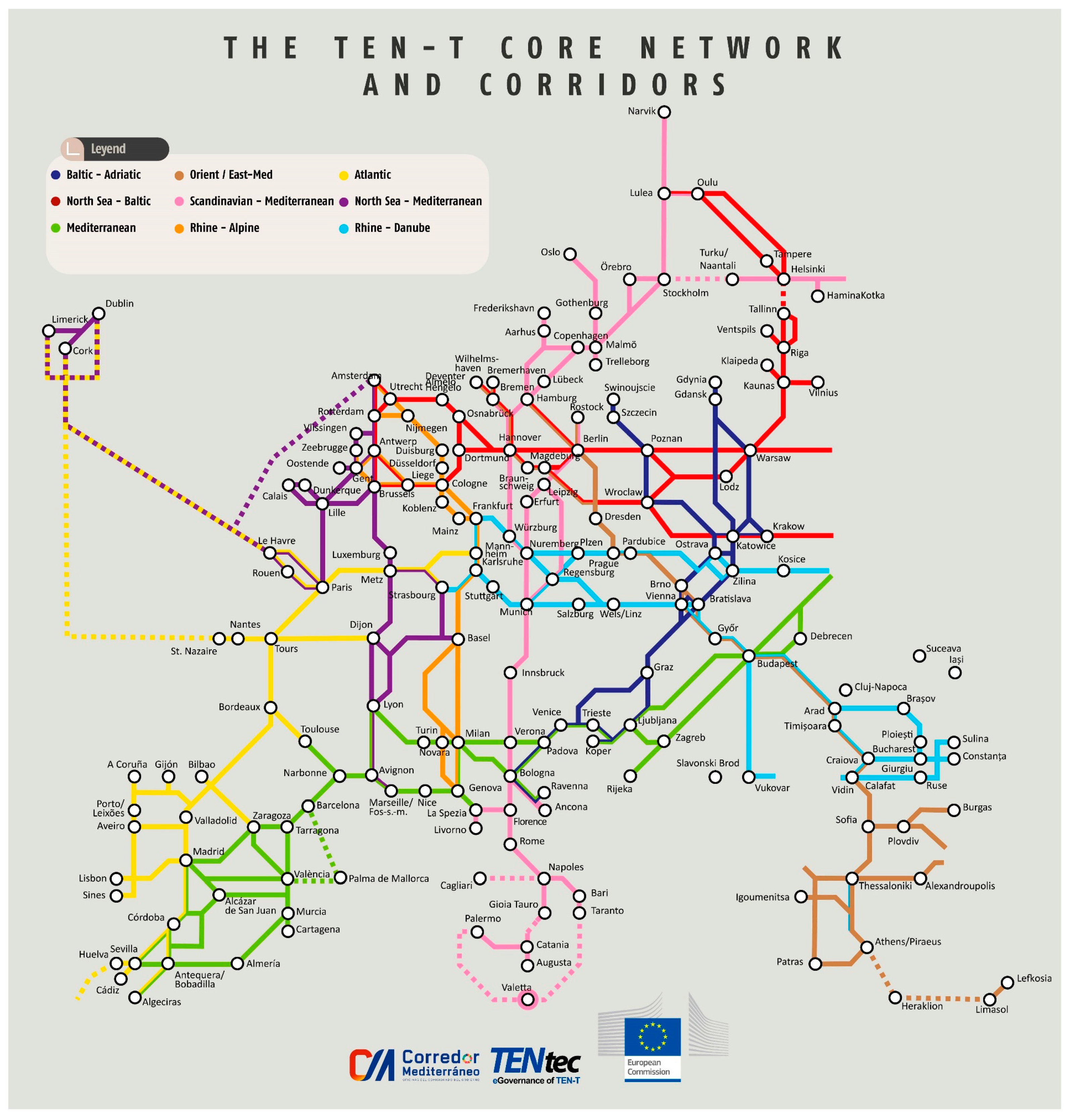
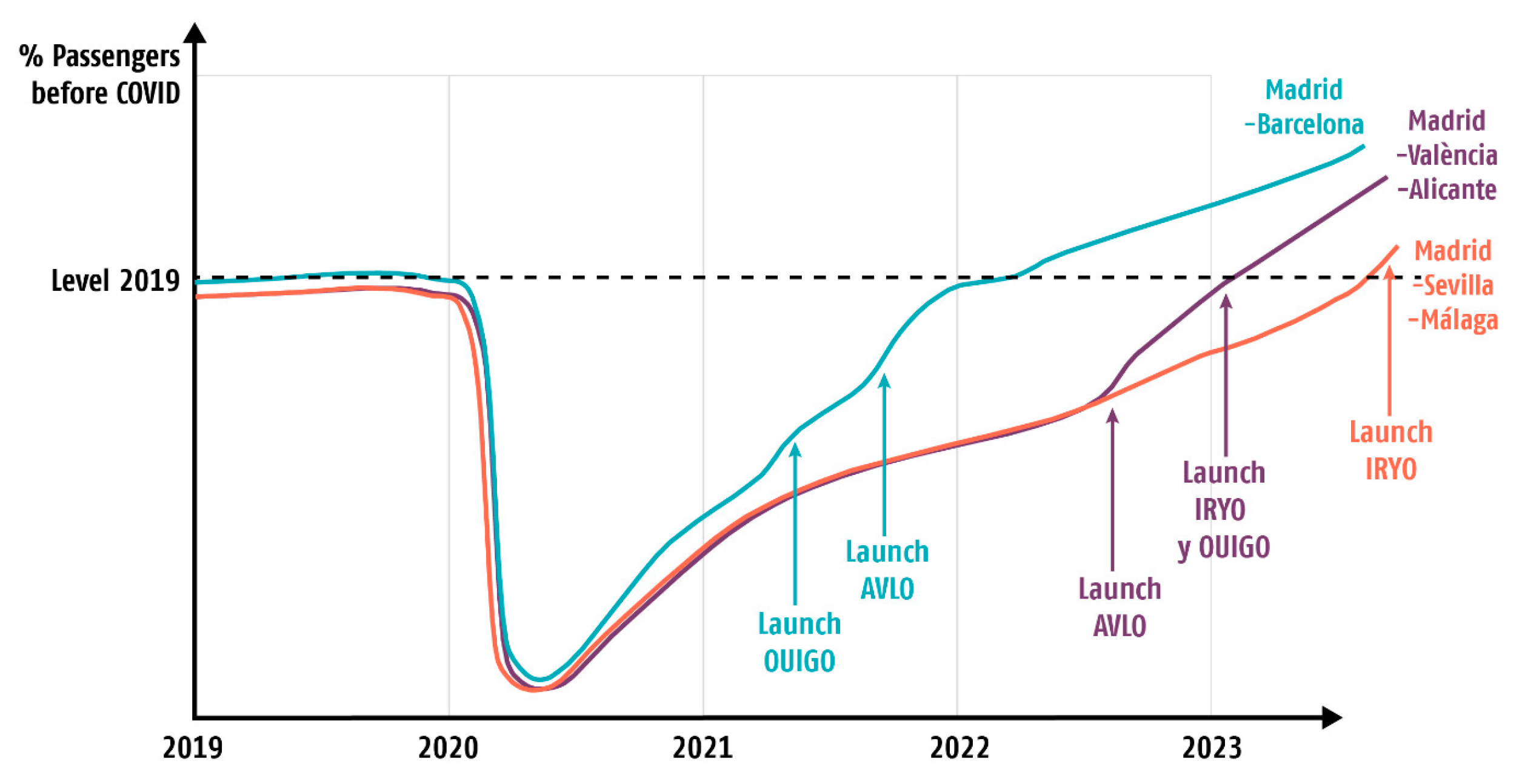



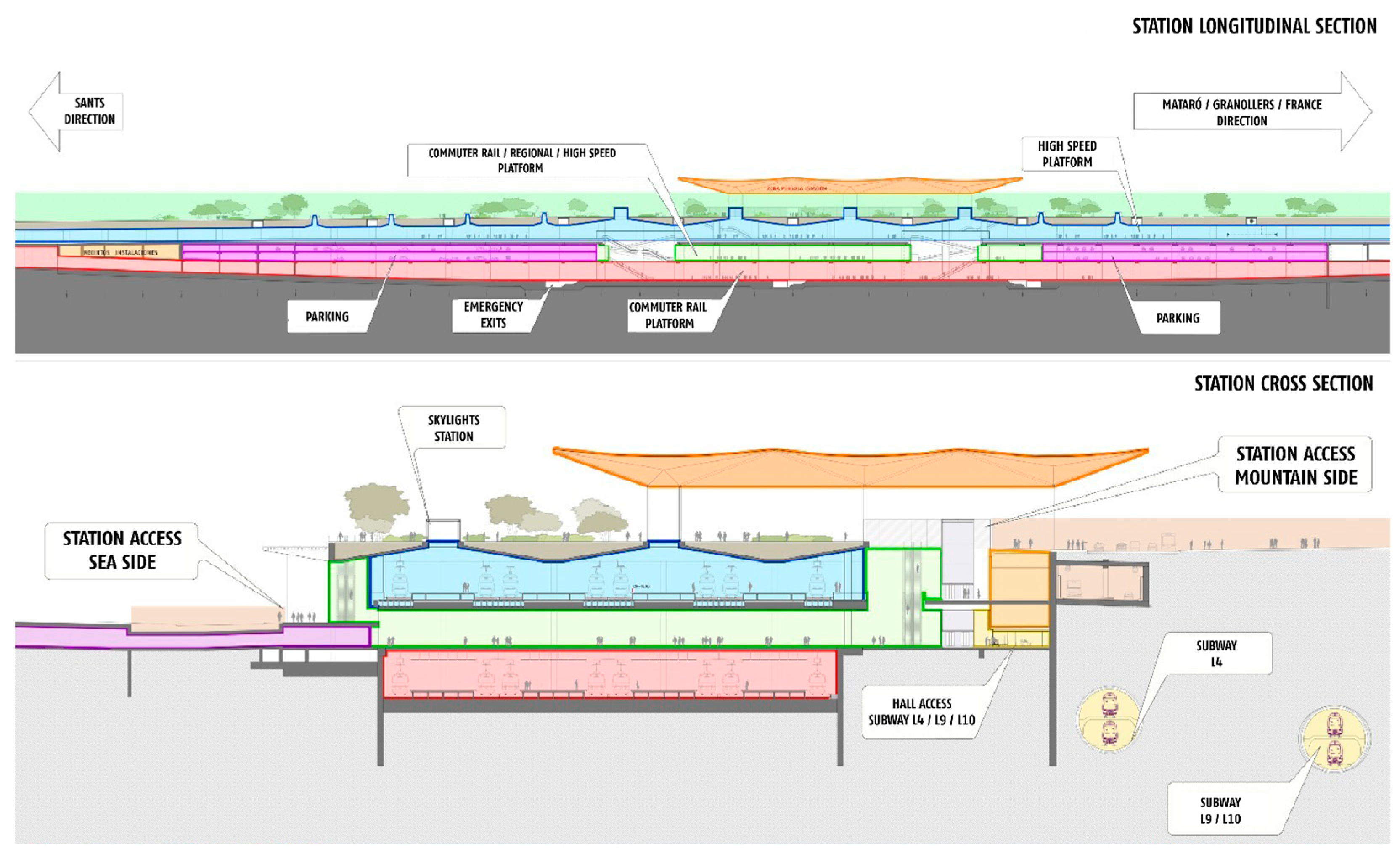
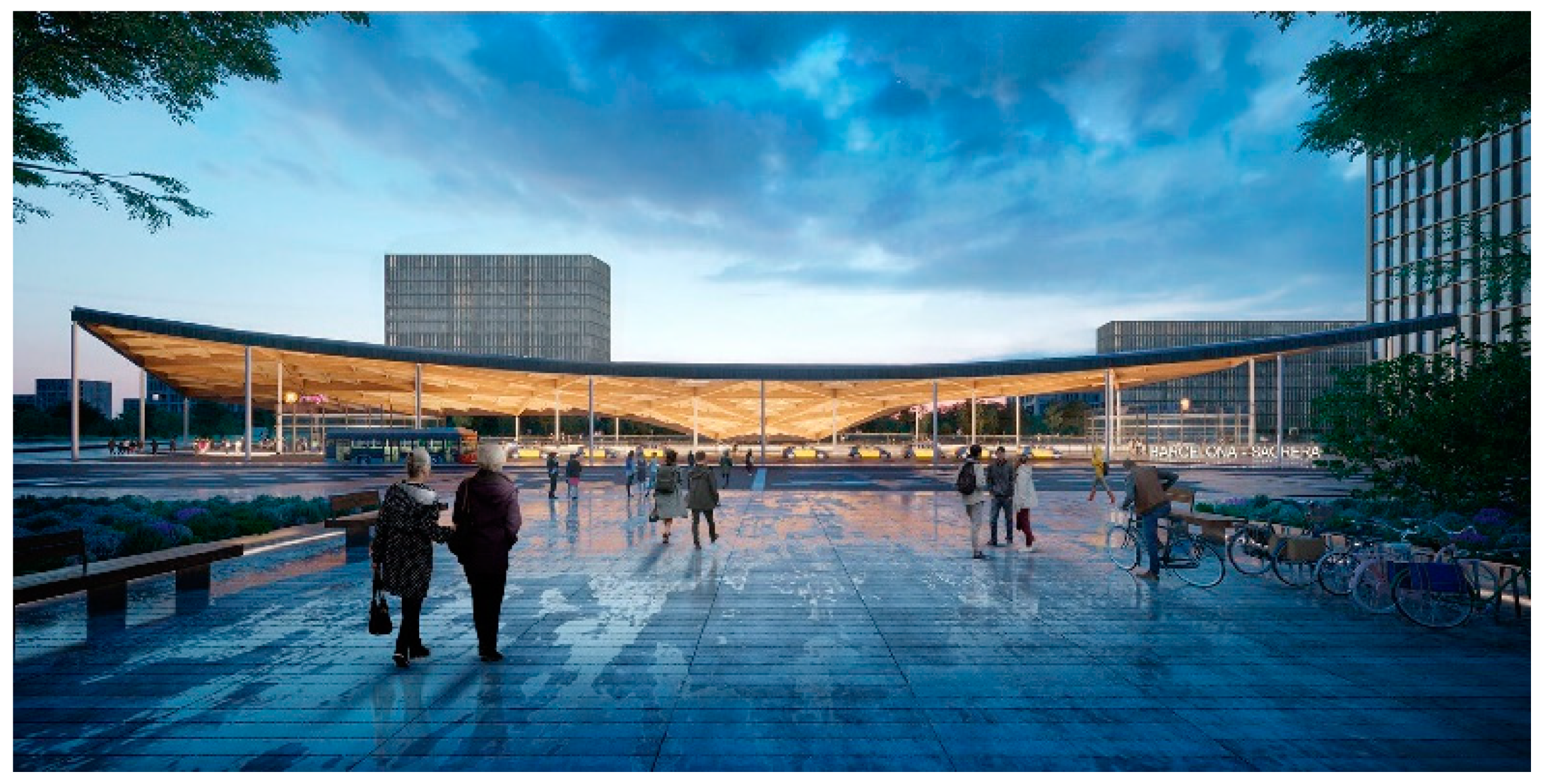
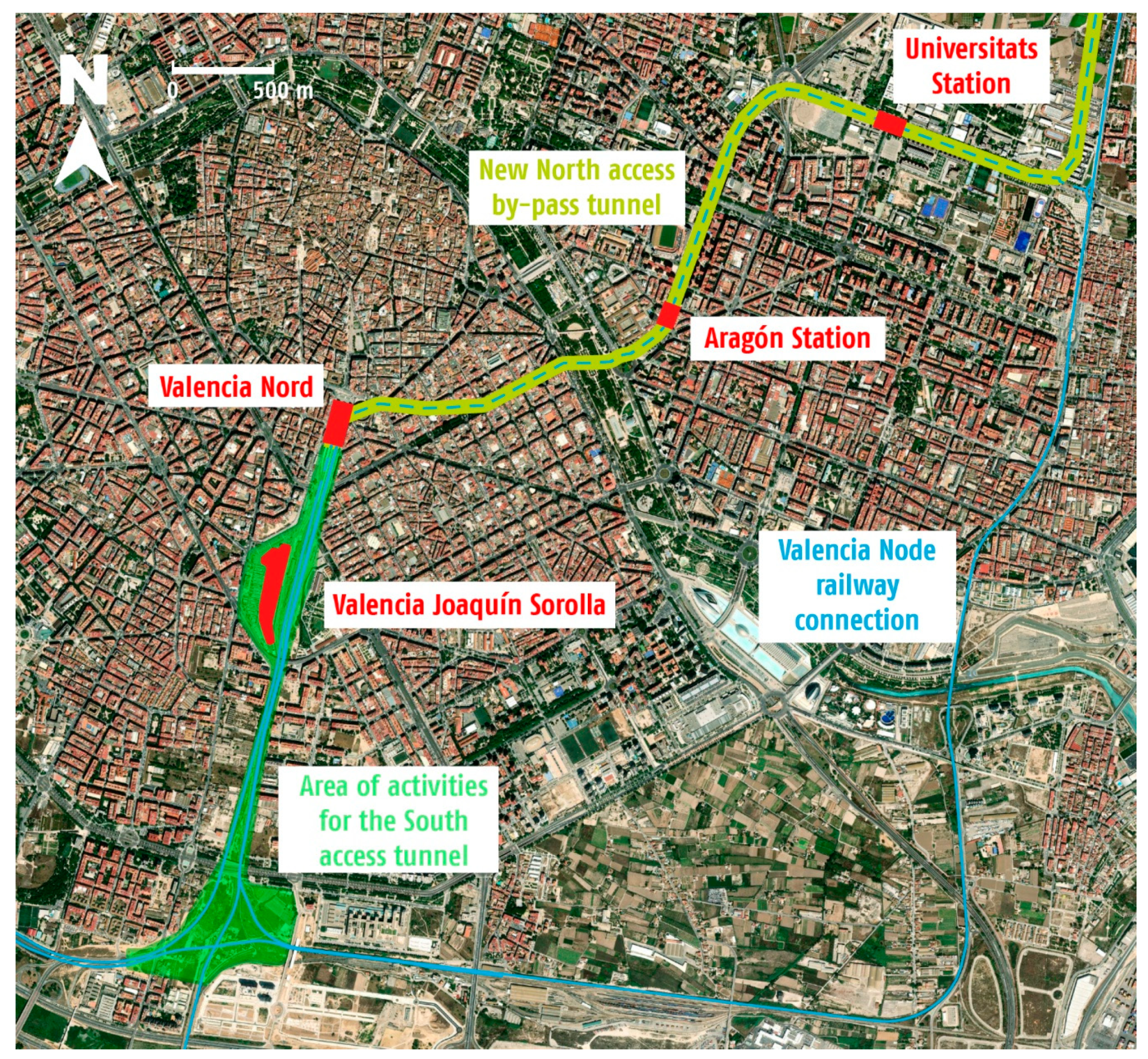

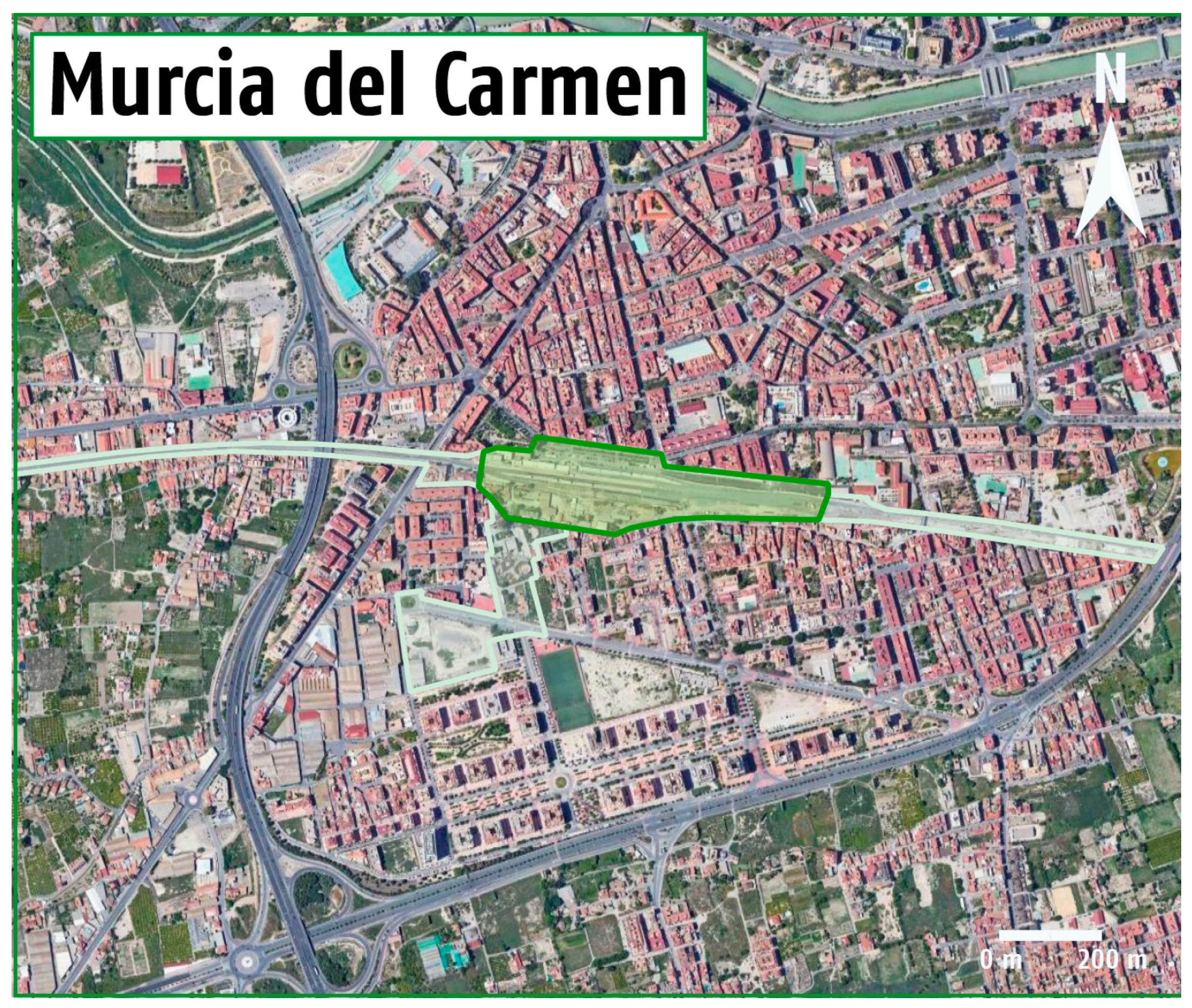

| TEN-T Strategy | 1315/2013 | COM (2021)812 | ||
|---|---|---|---|---|
| Urban nodes in Spain | Medit. Corridor | Total | Medit. Corridor | Total |
| 5 | 7 | 19 | 48 | |
| Urban integration approach | Soft (only on mobility) | Wider (mobility and planning) | ||
| Planning tools | NO | SUMP | ||
| Geographical approach | Municipalities | Functional Urban Areas | ||
| Country | Total RRF | Transportation | Transportation Out of RRF | Rail | Rail Out of Total Transport | Rail Out of Total RFF | Weighted Ranking |
|---|---|---|---|---|---|---|---|
| Germany | 27,949,882,000 | 5,927,000 | 0.02% | 727,000 | 12.27% | 0.00% | 6 |
| Poland | 58,100,000,000 | 7,518,000,000 | 12.94% | 4,023,000,000 | 53.51% | 6,92% | 4 |
| Romania | 29,000,000,000 | 9,620,000,000 | 33.17% | 5,000,000,000 | 51.98% | 17.24% | 1 |
| France | 40,000,000,000 | 7,700,000,000 | 19.25% | 4,700,000,000 | 61.04% | 11.75% | 3 |
| Spain | 69,528,000,000 | 13,203,000,000 | 18.99% | 6,268,000,000 | 47.47% | 9.02% | 3 |
| Italy | 191,500,000,000 | 33,980,000,000 | 17.74% | 28,710,000,000 | 84.49% | 14.99% | 2 |
| Portugal | 16,644,000,000 | 1,547,000,000 | 9.29% | 853,000,000 | 55.14% | 5.12% | 5 |
| Investment/Program | Amount (Million EUR) | Award Procedure |
|---|---|---|
| National Transport Network: European corridors | 2987.6 | Direct investment |
| National Transport Network: Trans-European Transport Network (other actions) | 1905 | Direct investment |
| Intermodality and logistics | 974.5 | Direct investment |
| Sustainable and digital transport support program | 800 | Competitive calls through the ministry or regions |
| Barcelona | Valencia | Murcia | ||
|---|---|---|---|---|
| Socioeconomic indicators | ||||
| Population (2020) a | Millions inhab. | 4.61 | 1.62 | 0.65 |
| Population (2030) b | Millions inhab. | 4.53 | 1.59 | 0.63 |
| Population density (2020) b | inhabitants/ha | 222.34 | 186.3 | 96.61 |
| Population density (2030) b | inhabitants/ha | 189.08 | 146.3 | 73.19 |
| Average income per person c | Thousand EUR per capita | 16.750 | 13.873 | 11.178 |
| Affected neighborhood by the railway project e and average income per person c,d | Name | La Verneda i la Pau, La Sagrera | Malilla, La Creu Coberta and Sant Marcel·lí | Santiago el Mayor |
| Thousand EUR per capita | 14.370 | 10.800 | 9.992 | |
| Mediterranean Railway Corridor’s projects | ||||
| Main project | La Sagrera TAV | Parc Central and Access Canal | El Carmen | |
| EU Funds e | Million EUR | 48.8 (NGEU) | 163 (NGEU) | ERDF |
| Railway Station | New station | Renovated station | Renovated station | |
| Functionality | Transport HUB—Reticular | Transport HUB | Linear | |
| Urban landscape | Linear green area (40 ha) | Core green area and permeability | Fringe and permeability | |
| Centralities | Displacement (Northern) | Reinforcing existing core | Reinforcing existing core | |
| Previous Stage | New Stage | |
|---|---|---|
| Scale and vision | National | European |
| Focus | High-speed network | TEN-T corridors |
| Funding | State aid with European aid | Greater weight of specific ordinary (CEF) and extraordinary (Next Generation) programs |
| Consequences | Self-financing (speculation?) | Public interest |
Disclaimer/Publisher’s Note: The statements, opinions and data contained in all publications are solely those of the individual author(s) and contributor(s) and not of MDPI and/or the editor(s). MDPI and/or the editor(s) disclaim responsibility for any injury to people or property resulting from any ideas, methods, instructions or products referred to in the content. |
© 2023 by the authors. Licensee MDPI, Basel, Switzerland. This article is an open access article distributed under the terms and conditions of the Creative Commons Attribution (CC BY) license (https://creativecommons.org/licenses/by/4.0/).
Share and Cite
Boira, J.V.; Berzi, M. Liberalization, Trans-European Corridors and EU Funds: A New Scenario in the Relationship between Rail Networks and Mediterranean Cities. Land 2023, 12, 1986. https://doi.org/10.3390/land12111986
Boira JV, Berzi M. Liberalization, Trans-European Corridors and EU Funds: A New Scenario in the Relationship between Rail Networks and Mediterranean Cities. Land. 2023; 12(11):1986. https://doi.org/10.3390/land12111986
Chicago/Turabian StyleBoira, Josep Vicent, and Matteo Berzi. 2023. "Liberalization, Trans-European Corridors and EU Funds: A New Scenario in the Relationship between Rail Networks and Mediterranean Cities" Land 12, no. 11: 1986. https://doi.org/10.3390/land12111986
APA StyleBoira, J. V., & Berzi, M. (2023). Liberalization, Trans-European Corridors and EU Funds: A New Scenario in the Relationship between Rail Networks and Mediterranean Cities. Land, 12(11), 1986. https://doi.org/10.3390/land12111986






